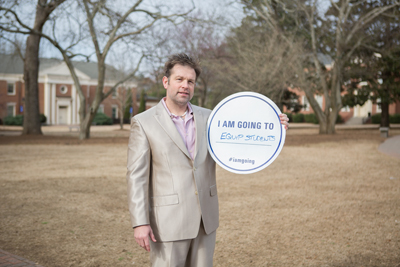Faculty Q & A with Stephen Eccher
CHRIS MARTIN | January 19, 2017


Q: Tell us about yourself.
A: I grew up in Maryland through middle school, during which time I came to embrace Christ at an evangelical Methodist church. I matriculated at Ball State University in Indiana where I initially pursued a degree in criminal justice with plans to follow in my father’s footsteps in the United States Secret Service. After two years at Ball State I began to consider a call to ministry. I transferred to Palm Beach Atlantic College (now University), where I played tennis, completed a Bachelor of Arts in Religion and married Cara, my bride of 15 years.
I pursued my M.Div. at Southeastern from 2000-2004 and we then moved to Scotland (UK) where I completed an M.Litt. and a Ph.D. at the University of St. Andrews. Cara and I have also been active members of Open Door Baptist Church since 2000. Cara and I have four princesses: Victoria, Emma and Sophia (identical twins), and Juliana.
Q: How did you come to SEBTS?
A: Just as I completed my Ph.D. while living in Wake Forest in 2011, Southeastern afforded me an opportunity to teach a theology class as an adjunct professor in fall 2012. I served as an adjunct for three semesters and was appointed full time in fall 2014.
Q: When people ask you, “What do you do at Southeastern,” what is your response?
A: I teach church history and historical theology. What I really do is more holistic; to support and enhance students in their present ministries, while simultaneously equipping them for future ministry.
Q: On what are you currently working?
A: I recently finished an article published last month in our theological journal. I am beginning the process of revising and broadening my Ph.D. dissertation for publication on the nature of religious dialogue between the Swiss Anabaptists and Reformers in the early modern period.
Q: What have you been reading recently?
A: I have been reading a book on Martin Luther by Oswald Bayer in preparation for a Ph.D. seminar. I just finished a book called “Following Zwingli” and a John Calvin biography. I am also reading primary source material from the early 16th century.
Q: When you get home from work, what do you look forward to doing?
A: I mostly invest my time in my four girls. This usually leaves me playing Disney princesses and My Little Pony. I love watching movies with my wife and playing golf and basketball with friends.
Q: Who are your role models?
A: My parents, Steve and Bev, gave me a picture of what it means to be a man of faith. I keep in contact with George Anderson, the former pastor of the Methodist church where I was saved. Bruce Gordon, my Ph.D. supervisor, inspires me in my passion for the Reformation. I have always looked up to Dr. John Hammett and Pastor Dwayne Milioni.
Q: What has God been teaching you lately?
A: The Lord has been teaching me about what long-term discipleship looks like for people without a background in church life. Two of my “classrooms” include a Southeastern mission trip to Edinburgh, Scotland and leading a care group with my best friend, Zach. God has been teaching me to seek faithfulness in what I do, and to not get caught up in my perfectionist tendencies.
Q: Where are some of your former students?
A: Some are full-time and bi-vocational pastors in North Carolina, Florida, and New England. Some are missionaries as far away as Japan and Russia. These students are my heroes and inspire me to pursue excellence in the classroom.
Q: When a student completes your class, what do you want him or her to walk away with at the end of the semester?
A: To walk away understanding that Christians do not function in a vacuum. We have historically done life, hermeneutics and theology in community. Isolated individualism can be dangerous. I emphasize the importance of context and how it has shaped the development of Christian thought.
Q: We always say that every classroom at SEBTS is a Great Commission classroom. What does that look like for your class?
A: I try to give my students an appreciation for the narrative of redemptive history. I believe it is important to see how God continues to reveal Himself and use people in history. God is also gathering a beautiful tapestry of people from the nations as pictured in Revelation 5.